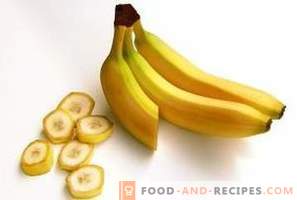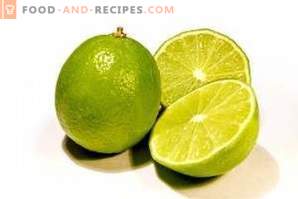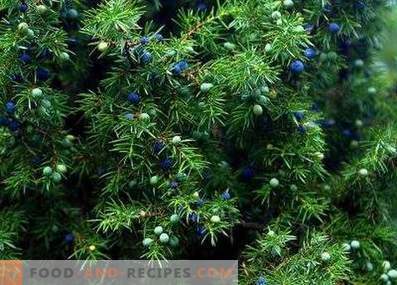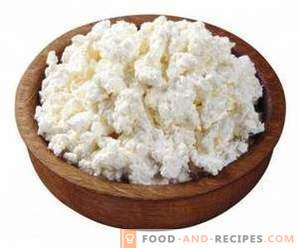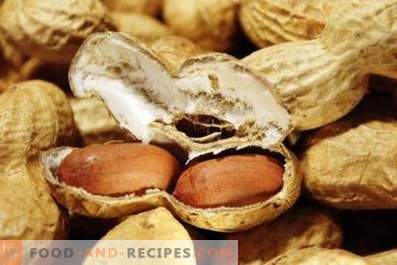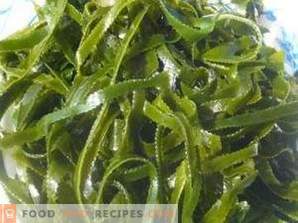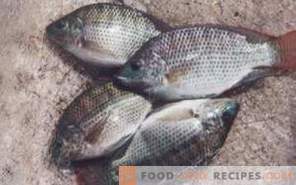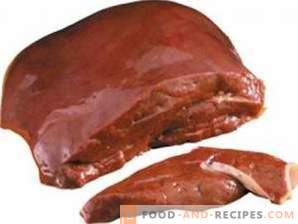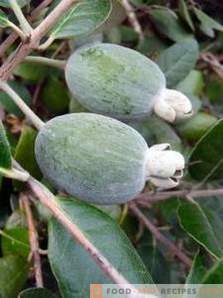
Description of Feijoa
Feijoa (lat. Acca sellowiana) is an evergreen plant belonging to the Myrta family and the genus Akka. This name applies to both the fruit itself and the feijoa shrub, which can often reach a height of four meters. Cultivation of this plant began only at the end of the 19th century, following its discovery by the Brazilian João de Silva Feujo. In honor of the aforementioned researcher and museum of natural history, the species was named.
The natural distribution area of feijoa are some regions of the South American continent: the highlands of Uruguay, Colombia, Brazil and Argentina. Soon after the appearance in the diet of Western peoples, feijoa became widely known in California and even in Eurasia. France began importing fruit in 1890, after 10 years the fruit reached the Black Sea coast, then the berries (feijoa sometimes determined this way) won the attention of Italy and the entire Mediterranean. Currently, the plant is actively distributed in countries with a subtropical and tropical climate. It stuck well in the Crimea, in the mountains of the Caucasus and the Krasnodar Territory. Feijoa’s world exports are primarily related to the following regions: France, Greece, Portugal, Spain, Sicily, New Zealand, Australia and the US Pacific coast. Experimental studies have shown that these flowering trees are able to withstand temperatures as low as -11C without damage to their condition. Feijoa maturation occurs in the autumn months (usually in October-November).
As mentioned above, feijoa is often called fruit, but from the point of view of biological description, fruits refer to berries that have a wide-round to oval shape. Fruit sizes vary from 2 to 5 cm in length and from 1.5 to 5 cm in diameter. The mass of berries ranges from 15 to 70 grams, in rare cases, the weight can reach 110 grams. Seeds of fruits are enclosed in a translucent white pulp. Berries can be called large, fleshy and juicy, and by taste, feijoa, as a rule, causes associations with kiwi, pineapple and strawberries. The peel of exotic fruits can be smooth or knobby; the first one most often corresponds to yellow-green color, and the second one is characteristic of dark green.
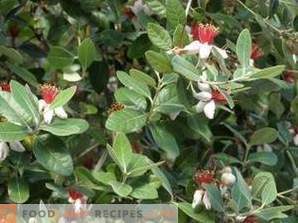
The presence of a rich vitamin-mineral composition and unique properties led to a wide use of feijoa both in its raw form and in the preparation of delicious dishes (jams, salads, drinks, canned foods, compotes, lemonades). Feijoa fruits are also very actively used in cosmetology, especially in the manufacture of face creams. When harvesting from the trees, it is the immature fruits that are trying to select so that they reach ripeness during transportation and storage. Otherwise, too soft ripe berries will very quickly lose their beneficial properties and rot. This tropical species also sometimes serves as landscape design, as its beautiful long flowering is highly valued by Japanese gardeners.
Vitamin complexes, macro- and microelements in the composition of feijoa
The incredible abundance of beneficial chemical compounds for the body is the reason that nutritionists actively recommend feijoa for general use. Like many tropical plants, feijoa berries form the basis of water. If you make a calculation for 100 g of feijoa fruit, then it will contain:
- 86 g of water
- 1, 2 g of proteins
- 0, 8 g of fats
- 10, 5 g of carbohydrates
- and even 0, 7 g of ash.
In terms of the content of vitamin complexes, this berry of the Myrtle family belongs to the absolute champions among similar products. Vitamins of group B, always necessary for the nervous and cardiovascular systems, for the processes of energy generation and normalization of digestion, as well as many other vital processes, are contained in feijoa. Quantities achieve very solid values:
- 0, 008 mg of thiamine (B1)
- 0, 032 mg of riboflavin (B2)
- 0, 289 mg of niacin acid (B3 or PP)
- 0, 228 mg of pantothenic acid (B5)
- 0.05 mg pyridoxine (B6)
- 38 μg of folic acid (B9)
- and 20, 3 mg of ascorbic acid (C).
Fruits are incredibly rich in organic acids and sugars. From macro - and micronutrients can distinguish significant amounts of the following components:
- 155 mg of potassium (K)
- 55 mg of copper (Cu)
- 8 to 35 mg iodine (I)
- 17 mg of calcium (Ca)
- 9 mg of magnesium (Mg)
- 3 mg of sodium (Na)
- 0.05 mg of manganese (Mn)
- and 0.04 mg zinc (Zn).
If the calculation is not based on the dry weight of the fruit, then in 1 kg of feijoa berries there are in the presence of 2, 05 to 3, 8 mg of iodine. It should be remembered that the average daily need for a person of middle age in iodine is 0.15 mg. Thanks to a number of studies, a pattern has been revealed of the content of this essential trace element quantity from the fruit growing area. For coastal trees, the content of iodine in the berries reaches the highest values, and at a distance of 40–90 km from the sea, the figures are about 8–9 mg per 100 g of fruits. Iodine in the composition of feijoa is water soluble and is very quickly absorbed.
Caloric and healthy properties of feijoa
Fresh feijoa has significant energy value. It accounts for approximately 50 calories per 100 grams of berries.
- The highest content of pure iodine in feijoa is comparable only with this value for seafood. Therefore, the fruit is recommended to use for the treatment and prevention of anemia, thyroid disorders, inflammation of the kidneys and gastric mucosa.
- Rich reserves of B vitamins make feijoa a stunning natural remedy. Vitamins B1 and B2 take part in metabolism and growth stimulation, and vitamin B2 catalyzes the production of corticosteroids. These components also contribute to blood formation, and in conjunction with ascorbic acid they do an excellent job with fatigue and eye diseases.
- Feijoa can also be useful for treating neuralgia and lumbago. This is due to the high content of vitamin B5, which is responsible for lipid metabolism, the processes of redox balance, and the functioning of the immune system. Vitamin B6 is essential for the central and peripheral nervous system.
- The presence of vitamin C in fruits makes the berries an effective antioxidant, so feijoa helps to overcome stress and protect against infections. Also, this product increases the permeability of blood vessels, saving them from fragility.
- Due to its potent anticarcinogenic effect, feijoa fruits are capable of lowering cholesterol levels in the blood, therefore it is useful to end up eating fried foods with such berries in order to minimize the harm from it. Some nutritionists recommend feijoa for type 2 diabetes because treatment requires a decrease in sugar level. Feijoa fruits contain relatively few sugars (most of them are fructose) and a small amount of calories.
- A lot of tannins are concentrated in the skin of berries, because of which fruits have a tart taste, as well as biologically active catechins and leucoanthocyanites were found in it. The combination of these antioxidant properties makes feijoa an important tool in the prevention of cancer.
- The aroma of essential oils, neutralizing the effect of viruses and pathogens, is very useful for the prevention of colds. The pleasant smell of feijoa, according to psychologists, actively accelerates longing.
- Feijoa fruits have found application in the cosmetic industry. Berries are the basis for masks that provide skin elasticity and reduce inflammation.
Contraindications to use
As a rule, feijoa is not capable of causing an allergic reaction, however, it is necessary to abandon the product with individual intolerance of its components. For example, this applies to those people who are contraindicated seafood. Due to the high iodine content, feijoa cannot be eaten with thyrotoxicosis (hyperthyroidism).
With severe obesity and the first type of diabetes mellitus is not recommended excessive use of feijoa.
